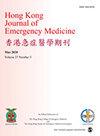抗凝血和抗血小板治疗史作为重症监护老年创伤患者输血需求的预测因素:一项基于登记的回顾性队列分析
IF 0.8
4区 医学
Q4 EMERGENCY MEDICINE
引用次数: 0
摘要
引言:随着预期寿命的延长,老年人因创伤入院的比例也有所增加。老年患者经常有潜在疾病,需要服用抗凝血剂/抗血小板药物,这会加重凝血障碍。我们确定了65岁以上患者在损伤前使用抗凝血剂/抗血小板药物与输血需求之间的关系 年。方法:这项回顾性研究纳入了2016年1月至2019年6月入住忠北国立大学医院创伤重症监护室的患者。使用卡方检验、独立t检验、单向方差分析和协方差分析对用药史、临床特征和成分输血的数据进行分析。结果:总的来说,142名和324名(总的466名)患者分别接受和未接受抗凝/抗血小板药物治疗。跌倒的频率更高(p < 0.001) = 36;25.4%vs n = 25;7.7%)。头部和颈部损伤在药物组患者中更为常见(58.5%vs 46.6%,p = 0.02),并且他们的损伤严重程度评分较低(ISS;18.2比20.2,p = 0.03),血清血红蛋白水平和凝血功能无差异。非药物组在4天内接受了更多的红细胞输注 抵达时间(2.24 vs 1.42个单位,p = 0.03)。事后分析显示,红细胞输注在4 非药物组和华法林组之间的到达时间(2.24 vs 0.33单位)。与其他损伤患者相比,头颈部损伤患者接受的红细胞较少(头颈部1.07;胸部和腹部2.73;骨盆和四肢3.34个单位,p < 0.001)。在线性回归分析中,损伤严重程度评分和格拉斯哥昏迷量表评分影响输血量。对损伤严重程度评分、格拉斯哥昏迷量表评分和主要损伤部位进行控制的多因素分析显示,输血需求没有组间差异。结论:65岁以上患者伤前抗凝/抗血小板药物的使用与输血量无显著相关性 年。本文章由计算机程序翻译,如有差异,请以英文原文为准。
History of anticoagulant and antiplatelet therapy as a predictive factor for transfusion requirement in elderly trauma patients in intensive care: A retrospective registry–based cohort analysis
Introduction: With increased life expectancy, the proportion of elderly trauma admissions has increased. Elderly patients frequently have underlying diseases necessitating anticoagulant/antiplatelet medication, which worsens coagulopathy. We ascertained the relationship between preinjury anticoagulants/antiplatelet medication use and transfusion requirements in patients older than 65 years. Methods: This retrospective study enrolled patients admitted to the trauma intensive care unit of Chungbuk National University Hospital during January 2016 to June 2019. Data on medication history, clinical features, and component transfusions were analyzed with the chi-square test, independent t-test, one-way analysis of variance, and analysis of covariance. Results: Overall, 142 and 324 (overall 466) patients did and did not receive anticoagulant/antiplatelet medication, respectively. Falls were more frequent (p < 0.001) in the medicated group (n = 36; 25.4% vs n = 25; 7.7%). Head and neck injuries were more frequent among patients in the medicated group (58.5% vs 46.6%, p = 0.02), and they had a lower Injury Severity Score (ISS; 18.2 vs 20.2, p = 0.03), with no difference in serum hemoglobin level and coagulation function. The non-medicated group received more red blood cell transfusions within 4 h of arrival (2.24 vs 1.42 units, p = 0.03). Post hoc analysis revealed differences in red blood cell transfusions within 4 h of arrival between the non-medicated and warfarin groups (2.24 vs 0.33 units). Patients with head and neck injuries received less red blood cells than patients with other injuries (head and neck 1.07; chest and abdomen 2.73; pelvic and extremity 3.34 units, p < 0.001). On linear regression analysis, the Injury Severity Score and Glasgow Coma Scale score influenced the transfusion volume. Multivariate analysis controlled for Injury Severity Score, Glasgow Coma Scale score, and main injury site showed no intergroup differences in transfusion requirements. Conclusion: Preinjury anticoagulant/antiplatelet medication use was not significantly associated with transfusion amounts in patients older than 65 years.
求助全文
通过发布文献求助,成功后即可免费获取论文全文。
去求助
来源期刊

Hong Kong Journal of Emergency Medicine
EMERGENCY MEDICINE-
CiteScore
1.50
自引率
16.70%
发文量
26
审稿时长
6-12 weeks
期刊介绍:
The Hong Kong Journal of Emergency Medicine is a peer-reviewed, open access journal which focusses on all aspects of clinical practice and emergency medicine research in the hospital and pre-hospital setting.
 求助内容:
求助内容: 应助结果提醒方式:
应助结果提醒方式:


